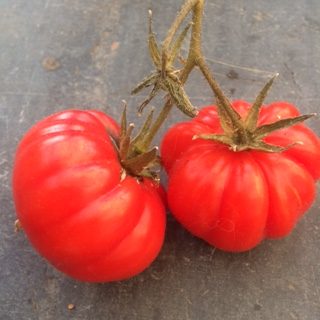
I am reaching the very end of the tomato crop that I grew in the glasshouse and polytunnel this summer, the last few that I picked green when the weather started to turn cold, and then left to ripen in a paper bag in a draw. I have checked them whenever I have remembered and they have slowly turned through green, bruised green, pinkish and finally a nice, tempting, edible red. Still tasty, even though they are not perhaps the finest specimens. With proper winter comes a dearth of decent tomatoes, so these last few home grown ones are precious even though they are nothing on September’s lot. Those that we buy from supermarkets will gradually become harder, paler and less tomato-like the deeper we get into winter, and finally I give them up and buy only tinned tomatoes, sealed in with all their flavour at the end of summer.
There are a couple of possible ways of extending the season though, and I have been planning for next year. In really mild spots it can be possible to grow your tomatoes into winter, with the aid of a glasshouse. A gardener I met in central London a few years ago – Wendy Shillam of rooftopvegplot.com – has her glasshouse on her roof top garden, and the combination of London’s warm microclimate, the garden being lifted off of the ground and away from pooling frosts, and the heat from the house rising meant that her greenhouse kept on producing tomatoes until Christmas. This may not be the case this year of course, when it has turned so cold so early, and hers are very particular circumstances that we cant even ape here in Bristol, one of the milder parts of the country due to our proximity to sea and to Gulf Stream. But in some years it is possible for at least some of us to keep ripening tomatoes beyond the traditional season.
There is another way, and it is one that I am keen to try partly just to keep the tomato party going longer next year, but also because it is a type of growing that has faded with the coming of canning, tinning, freezing, and year round. It’s a shame to lose these old ways completely, if only because we might need them one day, but also because they might just be really delicious. ‘Winter storage tomatoes’ are quickly vanishing, but there was a time when they would have been widely grown through southern Europe. They generally ripen a little later than other tomatoes, and they have a thicker skin, but both factors help them to last well into winter. They are picked when ripe and then stored in a cool larder or any cool, frost free spot, such as an unheated conservatory, porch or spare room, just as you would store ‘De Colgar’ is one of the few surviving varieties and is offered by Real Seeds www.realseeds.co.uk and I am adding it to my seed order as I am keen to try it out next year. The tomatoes are orangey pink, thick skinned, and low on juice, so not quite the same as a classic salad tomato but particularly good for making pan con tomate: toast bread and rub it with garlic then drizzle with olive oil, and then ‘grate’ the tomato over it. It wont grate like a pice of cheese will but the flesh will rub through the grater and the thick skin will be left behind. This makes a very cheering breakfast, but particularly in winter, and particularly – I imagine – when made with tomatoes that you’ve sown and grown and then stored into the depths of winter yourself.










